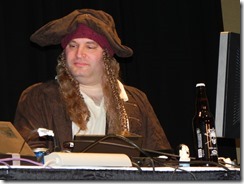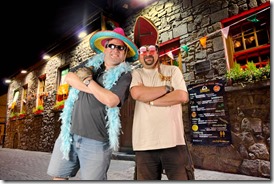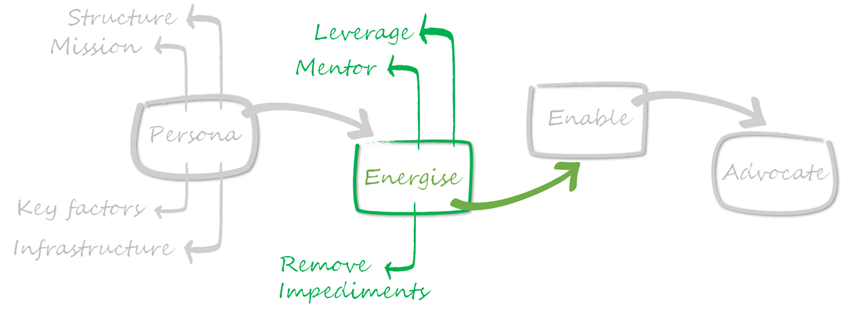Fun of PM.2 … Energi[s|z]ing the team
Continuing with the program management (PM) persona from Fun of PM.1 … Persona within the ALM Rangers, we focus on Energize in this post.
We focus today’s post on Energize, which breaks down into leverage, mentor, and remove impediments sub-topics.
leverage
The Program Manager (PM) leverages resources and orchestrates agendas, skills, and personalities to encourage a vibrant, passionate, and cohesive team. It is important to identify different personalities, traditions, and cultures, especially those that avoid disputes or will not question (apparent) authority. The PM needs to encourage a delicate balance of tampering the extraverts and encouraging the introverts. Remember, there is no “I” in team! When the team works as “one” and has all the tools it needs, the passion, quality, dream, innovation and energy levels will rise to new levels.

 Robert Bernstein and Willy-Peter Schaub balancing work & fun @ TechReady.
Robert Bernstein and Willy-Peter Schaub balancing work & fun @ TechReady.
! Leverage and orchestrate resources to enable the “dream” team and lead by example.
remove impediments
Similar to a flight controller helping pilots avoid turbulence or assisting them in an emergency, a Program Manager (PM) works with the team, stakeholders and in particular, the Scrum/Ruck master, to proactively identify potential impediments and take ownership of known impediments and the resolution thereof.
 … image sitting in the project control tower as PM.
… image sitting in the project control tower as PM.
Common Ranger project impediments and PM actions:
- Team member goes dark or is unavailable due to a family emergency.
PM finds a replacement resource or takes ownership of responsibilities, assumes the role and delivers on behalf of the unavailable team member. - Team requires a special infrastructure in the upcoming sprint(s).
PM works with stakeholders to prepare and support the infrastructure. - Team is bogged down trying to align documentation with the common template and styling.
PM encourages the team to work with a basic template, i.e. FastStart - Contributor.dotx, and takes ownership of merging and aligning the documentation, and collaborating with the copy editor to maintain a consistent style and readability. - Team is blocked due to a technical issue or product bug.
PM collaborates with the stakeholders and product teams to identify and resolve the issue / bug. - Stakeholders introduce scope-creep and churn, unsettling team and impacting deliverables.
PM collaborates with the stakeholders to avoid scope creep and move scope-creep to subsequent release backlogs. - team is missing the quality bar or are not meeting the definition of done (DoD).
PM does whatever needs to be done to assist the team to “ship”. The buck stops with the PM!
Knowing that there is always an understanding sounding board, supporting wingman and encouraging mentor, allows the team to focus on their core commitments and intuitively energises them.
! Avoid turbulence, to enable and focus the team.
mentor
As mentioned in Fun of PM.1, we are investigating peer mentorship as another effective strategy to bridge the ecosystems.
Mentors are wise, trusted advisors, who help others learn and awaken, who inspire and convey their wisdom without teaching or managing.
New PMs connect with practiced PMs as peer mentors enabling them to assimilate themselves into the world of PMs quicker and more effectively, while creating a two-way learning experience.
Similarly, ALM Ranger PMs connect with feature PMs as peer mentors. This enables the exploration of different environments, PM skills and responsibilities, and creates another two-way learning experience and creates the foundation of another bridge.
! A peer mentorship is an effective enabler and awakener.
energizing through leadership
The Program Manager leads, not manages, by example and by morphing into whatever persona the team needs to keep the ship on track and the team unblocked. We base the illustration below on a typical four four-week sprint ALM Ranger project, with a Scrum/Ruck Master (RM), Product Owner (PO), Project Lead (PL), 3 engineering pairs, and the Program Manager (PM). As always, all roles, except the program manager, are volunteers, geographically distributed and part-time.
The PM wears several hats during a typical project, including developer, contributor, tester, reviewer, PO proxy, backup Scrum/Ruck Master, enforcer of quality, consistency and scope, pizza coordinator and release advocate. A “Jack of all trades” or “Tron of all bits.”
During the Training-Research-Planning (TRP) sprint, the PM supports the RM, PO, and PL, taking ownership of setting up and supporting the team infrastructure, collaborates with the RM and PL to populate the backlogs and synchronizes with the PO to ensure the objectives, vision and backlog meets the PO’s acceptance criteria. The PM is responsible for creating the right platform for the team to catapult into the development sprints, and understanding the context of the project to be able to shield and become a proxy for the PO. The PM’s involvement typically spikes at the beginning and end of the TRP sprint as shown.
During the development sprints, the PM gets involved as contributor, developer, reviewer, tester, backup lead, PO proxy and whatever other persona/role the team needs to keep the team energised and unblocked. The review, testing, and planning activities spike at the end of each development sprint, where the PM drives the milestones and especially quality bars. Engineers should focus on their work during their precious part-time slices, and then intentionally re-focus on their family time and/or “real” job. The PM should worry about dotting their i’s and crossing their t’s in terms of process, style, quality, plans and collaboration for the team.
The team needs the greatest commitment by the PM during the Quality-Planning (QP) sprint, to enforce the no-scope-creep and we ship-today-and-improve-tomorrow mantras. In addition the PM becomes the release handyman, helping the team resolve the last few bugs and gremlins, completing quality essential processes, packaging the release with the PL and working with the PO to get the infamous “thumbs up” to ship a silent BETA and eventually the release. The PM morphs into whatever personas the team needs to ship and to ensure the team is drenched with Kudos and recognition when the PO gives the approval to ship.
! Do you have any problem with your project? Call the Program Manager … or, wait, the problem was pro-actively addressed … wow, now I have energy for the next challenge q:)
… call to action!
At this point, we have skimmed persona and energise topics of the Program Manager (PM), within the context of the ALM Rangers. In the next post, we will investigate how the PM enables the team, building invaluable bridges.
? Thoughts? Candid feedback?
! We need your feedback and questions to fuel these discussions and help us improve our mentoring program.
special thanks
Special thanks to Anisha Pindoria and Rui Melo, who help me improve these posts as part of our peer mentorship, and Bill Heys, who turns my gibberish into human readable content.




